創造論ネタ
聖書で、人間の言葉をしゃべった動物は、エデンの園のヘビ(創世記)とバラムのロバ(民数記22章)の2匹だけである。
ヘビがしゃべるのは創世記3章で...
呪われる前のヘビの姿について、創世記には設定情報がない。したがって、絵画にも様々なパターンがあり、二足歩行する上半身が人間なリザードマンから、まったくのヘビまでいる。
たとえば、上半身は人間の女性で、二足歩行するリザードマンに近いヘビ。
顔だけ人間な、二足歩行するリザードマンに近いヘビもいる。
上半身は人間だが、下半身は人間の体がヘビのように長くなっている場合もある。
これも上半身は人間だが、下半身は普通にヘビとなっている。
そして、これは顔だけ人間の女性で、その下はまったくのヘビ
そして、普通にヘビ。
創世記に設定がないため、これを補完しようという人々は古来よりいた。
Martin Lutherは懲罰前のヘビは、非常に美しいものだったと主張する。
これに対して、John Calvinはもともとヘビはヘビという立場。
若い地球の創造論ミニストリ"Answers in Genesis"は、もともとヘビには足があったという立場をとっている。

聖書で、人間の言葉をしゃべった動物は、エデンの園のヘビ(創世記)とバラムのロバ(民数記22章)の2匹だけである。
ヘビがしゃべるのは創世記3章で...
創世記 3章1-6節
主なる神が造られた野の生き物のうちで、最も賢いのは蛇であった。蛇は女に言った。「園のどの木からも食べてはいけない、などと神は言われたのか。」
女は蛇に答えた。「わたしたちは園の木の果実を食べてもよいのです。でも、園の中央に生えている木の果実だけは、食べてはいけない、触れてもいけない、死んではいけないから、と神様はおっしゃいました。」
蛇は女に言った。「決して死ぬことはない。それを食べると、目が開け、神のように善悪を知るものとなることを神はご存じなのだ。」
女が見ると、その木はいかにもおいしそうで、目を引き付け、賢くなるように唆していた。女は実を取って食べ、一緒にいた男にも渡したので、彼も食べた。
創世記 3章14-15節
主なる神は、蛇に向かって言われた。「このようなことをしたお前は/あらゆる家畜、あらゆる野の獣の中で/呪われるものとなった。お前は、生涯這いまわり、塵を食らう。
お前と女、お前の子孫と女の子孫の間に/わたしは敵意を置く。彼はお前の頭を砕き/お前は彼のかかとを砕く。」
呪われる前のヘビの姿について、創世記には設定情報がない。したがって、絵画にも様々なパターンがあり、二足歩行する上半身が人間なリザードマンから、まったくのヘビまでいる。
たとえば、上半身は人間の女性で、二足歩行するリザードマンに近いヘビ。
Adam and Eve (manuscript illumination), 15th c.
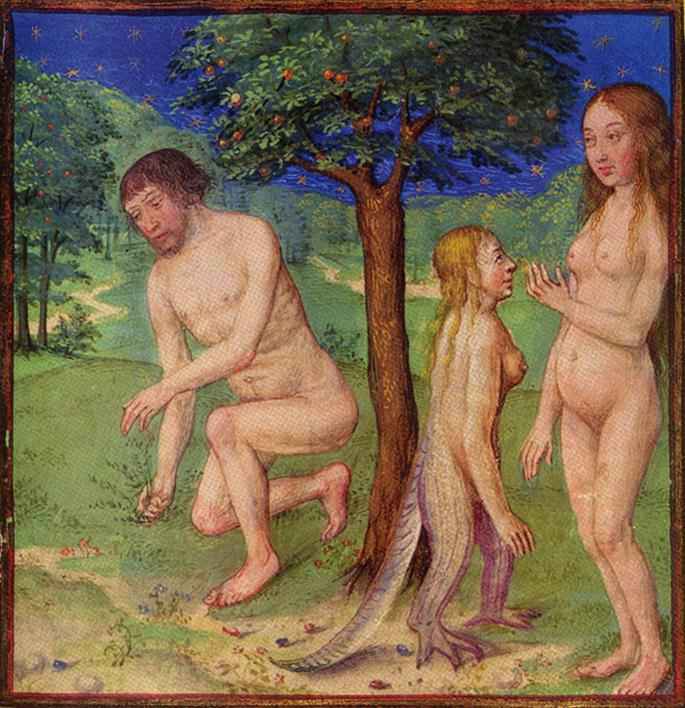
顔だけ人間な、二足歩行するリザードマンに近いヘビもいる。
Hugo van der Goes (1440-1482): "Original Sin" (1467-1468) at Kunsthistorisches Museum, Vienna.
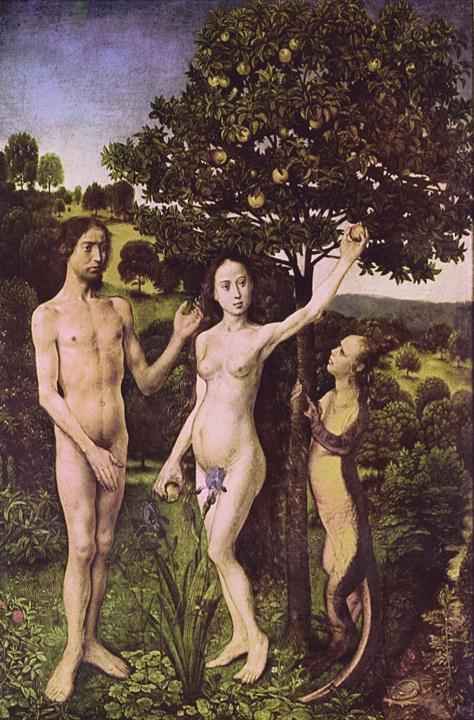
上半身は人間だが、下半身は人間の体がヘビのように長くなっている場合もある。
Michelangelo Buonarotti (1475-1564): "Temptation and Fall" from the Sistine Chapel Ceiling.
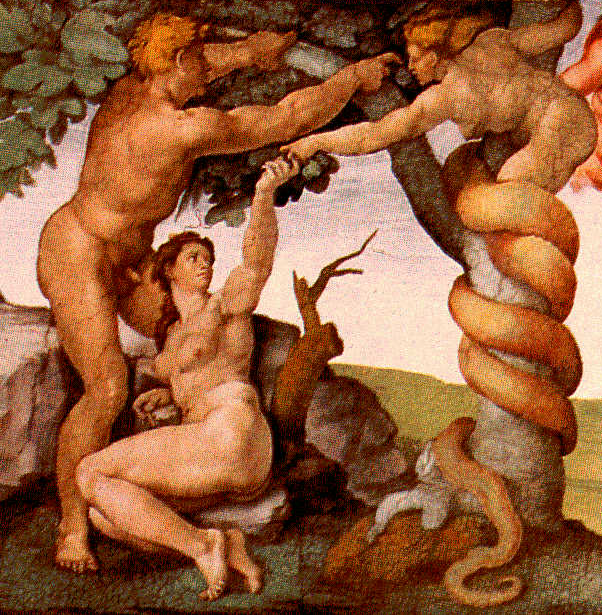
これも上半身は人間だが、下半身は普通にヘビとなっている。
Titian (1480-1576): "The Fall of Man" (1570), Prado Museum, Madrid.

そして、これは顔だけ人間の女性で、その下はまったくのヘビ
Tommaso Masolino Da Panicale (1383-1440): "The Temptation of Adam and Eve" (1427)
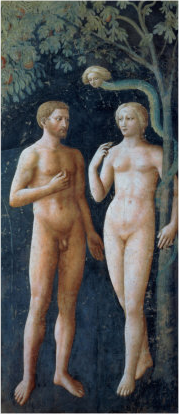
そして、普通にヘビ。
Lucas Cranach the Elder (1472–1553) : "Adam and Eve" (1526) at Courtauld Gallery, London.
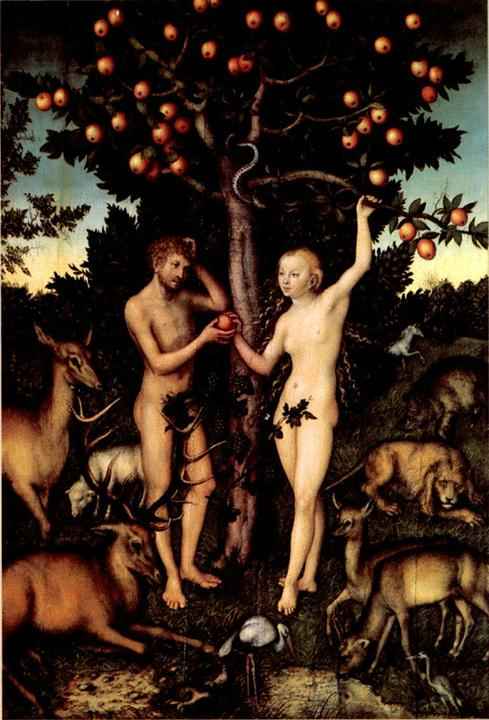
創世記に設定がないため、これを補完しようという人々は古来よりいた。
Martin Lutherは懲罰前のヘビは、非常に美しいものだったと主張する。
By this portion of the sacred record we are also instructed concerning the divine permission; that God sometimes permits the devil to enter into beasts, as he here entered into the serpent. For there can be no doubt that the serpent, in the assumption of whose form Satan talked with Eve was a real and natural serpent. But when men enter into discussions whether this serpent assumed on that occasion a human countenance, etc., all such discussions are absurd. The creature was doubtless a most beautiful serpent in its natural state; otherwise Eve would not have conversed with it so securely. After the sin of the fall however that beauty of the serpent was changed. For God's rebuke to him declares that hereafter "he should go upon his belly on the ground." Whereas before, he walked upright, as the male fowl. God also declares "that he should eat dust," whereas before, he fed upon better food, even upon the productions of the earth. Nay, even the original security of man with the serpent is lost. We flee from serpents at the sight of them, as they also flee from us.
THE PRECIOUS AND SACRED WRITINGS OF MARTIN LUTHER (English translation), pp.238-239
これに対して、John Calvinはもともとヘビはヘビという立場。
This objection has induced certain men of learning and ability to say, that the serpent had been accustomed to walk with an erect body before it had been abused by Satan. There will, however, be no absurdity in supposing, that the serpent was again consigned to that former condition, to which he was already naturally subject. For thus he, who had exalted himself against the image of God, was to be thrust back into his proper rank; as if it had been said, Thou, a wretched and filthy animal, hast dared to rise up against man, whom I appointed to the dominion of the whole world; as if, truly, thou, who art fixed to the earth, hadst any right to penetrate into heaven. Therefore, I now throw thee back again to the place whence thou hast attempted to emerge, that thou mayest learn to be contented with thy lot, and no more exalt thyself, to man's reproach and injury.'
Calvin's Commentaries
若い地球の創造論ミニストリ"Answers in Genesis"は、もともとヘビには足があったという立場をとっている。
The more logical answer is that the serpent originally had some form of legs or appendages, and these were either lost or reduced (consider how many reptiles crawl on their bellies and yet have legs, e.g., crocodiles). This seems to correlate with the plainest reading of the passage and the comparison of a curse (“on your belly you shall go”) as compared with cattle and other beasts of the field, which do have legs.
Thorns and thistles were brought forth due to the curse (physical changes to vegetation); there were physical changes to the man and woman (increased sorrow in childbearing and increased pain in work that has been passed along). There is no reason to assume the serpent didn’t undergo physical changes as well—he was a prime culprit. These physical changes due to the curse help explain certain defense and attack structures (DAS) in animals and plants that currently dominate the world.
[ Bodie Hodge:"Did the Serpent Originally Have Legs?"(2010/01/26) on AnswersInGenesis ]
Thorns and thistles were brought forth due to the curse (physical changes to vegetation); there were physical changes to the man and woman (increased sorrow in childbearing and increased pain in work that has been passed along). There is no reason to assume the serpent didn’t undergo physical changes as well—he was a prime culprit. These physical changes due to the curse help explain certain defense and attack structures (DAS) in animals and plants that currently dominate the world.
[ Bodie Hodge:"Did the Serpent Originally Have Legs?"(2010/01/26) on AnswersInGenesis ]


コメントをかく